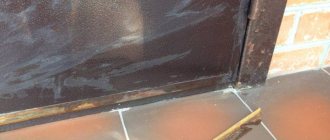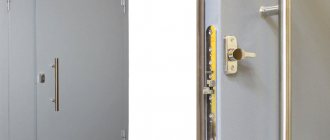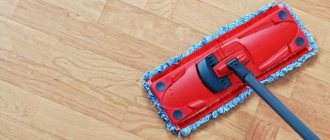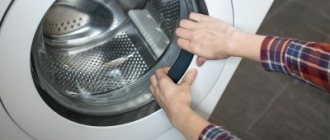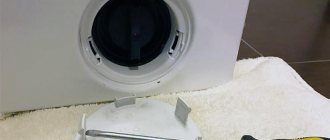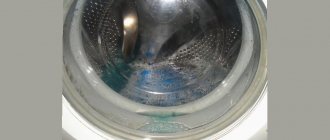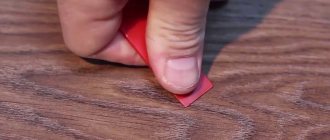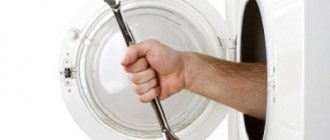Buying an entrance door is quite simple, but its installation and subsequent maintenance is much more difficult. The most common problem is contamination of the door leaf with foam or paint during installation or during renovation work in the apartment. Small splashes of foam or paint significantly spoil the aesthetic appearance of the product. How to clean a door leaf from such stains without damaging it?
How to remove old paint from wooden windows?
To clean a wooden window or door from old paint, you need to direct the air flow from a hot air gun directly onto the painted surface. Then wait until the first bubbles appear on the window frame. When this happens, use a spatula or scraper to pick up and collect the paint.
Interesting materials:
How to increase color saturation on a laptop screen? How to increase RAM on a laptop? How to increase the font on a laptop in YouTube? How to increase Internet speed on a laptop? How to increase screen timeout on laptop? How to increase the sound on a Lenovo laptop using the keyboard? How to find out the screen refresh rate on a laptop? How to find out what is occupied by laptop memory? How do you know if the video card in your laptop is burned out? How to find out information about a laptop?
Should I delete it?
When choosing a method for removing old paint, the question may arise: does it need to be removed at all? The answer to this question and the choice of coating removal method depend on the following factors:
- door surface type;
- condition of the coating;
- type of paint used;
- adhesion strength of the coating to wood;
- thickness and number of layers.
The most difficult thing will be to remove the layer of paint coating, which has good adhesion to the material, and the door itself has a complex surface topography and a lot of decorative elements.
If the door is designed for subsequent painting, then,
depending on the condition of the coating, you can get by with sanding it with sandpaper .
This is possible when the paint was applied carefully in one layer and does not contain peeling or chipping. The old coating is simply treated with sandpaper, and a new layer can be applied. Old layers of paint that, due to atmospheric influences and time, have significant defects (chips, cracks, swelling) will have to be removed. It is also necessary to remove too thick a layer of paintwork that has hardened streaks and other results of careless handling of the door in the past.
It happens that new door paint is incompatible with the old one. This is also a reason to completely remove paint from wooden doors.
How to eliminate the effects of corrosion: remove rust, fill dents and holes
Despite their strength, metal structures are constantly subject to surface damage: dents, holes, rust and stains can damage almost any metal. But with careful protection or simple repairs, it can be maintained or restored to its original splendor.
The most common form of corrosion is rust, which is the result of iron and steel exposed to moist air, which is iron hydroxide.
Dents, holes and rust ruin almost any metal.
To prevent corrosion of iron handrails, drainage systems, roofs and other structures, their surfaces must be protected with special coatings. However, they also wear out over time and require updating or replacement.
Removing rust and dirt
To obtain the best protection for any coating, remove all rust, dirt, loose paint and oxide tarnish from the surface of the metal being coated. The most convenient way to do this is to use wire brushes and a drill.
- Attach a wire brush attachment to your electric drill and, wearing glasses, sand the metal at high speed to remove rust and loose paint.
- Continue until the surface is smooth; There is no need to remove paint that is firmly adhered to the metal.
Using a power drill and wire brush to remove rust and dirt
Once the metal is smooth, you can sand it with silicon carbide sandpaper ranging from No. 40 (coarse abrasive, equivalent to No. 40-grit by Western standards) to M 50 (extra fine abrasive, equivalent to 320-grit by Western standards) if you need a smoother surface .
Using a soft cloth dampened with alcohol, wipe the surface clean and apply the finish of your choice.
Repairing dents
Dents and holes can also mar the surface of the metal, but there are simple steps you can take to repair the damage. Dents in thin metal can usually be knocked out into their original shape. If traces of impacts remain, the damaged area can be heated and the metal again given the desired shape.
Punching out small dents
Using a Sandbag
Punching out a small dent using a sandbag
- Place the area with the dent, if it can be accessed, on a plastic or cloth bag of sand.
- Then lightly tap out the dent with a wooden or rubber mallet until the metal returns to its original shape.
How to clean frosted or glossy glass
During the renovation process, construction waste may fall on glass elements. How and with what to remove dirt from frosted or glossy glass on a door?
The glossy surface of the glass can be washed with regular glass cleaner. For this purpose, what is always on hand in the house - citric acid, vinegar, alcohol solution - is also suitable.
To clean frosted glass, in addition to the usual glass cleaner, you can use a special care composition that carefully removes stains without damaging the glass structure.
Regardless of the material the door is made from, try not to use strong chemicals or abrasives.
Heat treatment
Acrylic and oil paints can be softened not only by chemical means, but also by heating. Previously, irons, gas torches and blowtorches were used for this. Today these devices are practically not used. A construction hair dryer allows you to remove old paint more efficiently and contributes to much greater safety.
A technical hair dryer is used to heat a small area of the surface, causing the coating to begin to bubble. After this, it can be easily removed with a spatula. It is most convenient to do this work in pairs: one person heats, the second works as a scraper.
You cannot remove paint in this way near plastic windows and panels, baseboards, as well as sockets, electrical and pipelines.
Methods for cleaning polyurethane foam
Polyurethane foam dries quickly, so the sooner work begins, the greater the chance of cleaning the door without leaving a defect on it. In order to wash fresh polyurethane foam, a special remover or solvent is used.
It is much more difficult to clean dried traces of foam. You can do this as follows:
- Trim the remaining foam as close to the door covering as possible.
- Cover it with solvent, special remover or vinegar. When the foam gets wet, try cleaning the stains using a scraper or a stiff sponge.
- For best results, use a squeegee that is harder than foam but softer than the surface of the door. Clean away traces of foam until you get rid of them completely.
Epostat-Putty - epoxy putty for metal
Metal putty is a suspension of fillers and pigments in a solution of targeted additives, organic solvents and epoxy resins.
Designed for leveling surfaces: metal and non-metal. Surfaces can be primed or simply cleaned. Can be used as a primer for paints and varnishes.
Epoxy putty is resistant to gasoline, mineral oils, detergents, and is highly water resistant. Sands well.
Operating temperature ranges from –50 °C to +120 °C .
Dries quickly enough to degree 4: At +20 °C - within a day . At t +65 °C - in 7 hours .
Purpose
Epostat-Putty is used as an intermediate or first layer in coating systems for products used in aggressive industrial atmospheres and indoors.
It is applied to products and equipment in petrochemical, chemical, oil refining, nuclear, pharmaceutical, food and power plants, in automotive and shipbuilding.
Attention!
- Supplied in lithographed containers!
- The label is equipped with protective elements against counterfeiting!
Mode of application
The putty is applied to the surface primed with Phosphogrunt .
Before painting, clean unprimed surfaces to degree Sa 2½ according to ISO 8501 (from oil, grease and dirt, as well as from mill scale, rust, paint and foreign particles). Degrease oily surfaces with special degreaser OM-01S
component A until smooth using a low-speed drill with an attachment (2-3 minutes). Add Component B (hardener) to the base and mix thoroughly for at least 10 minutes. The hardener is supplied complete.
- After mixing, the putty should sit for 20-30 minutes .
- Apply at temperature: from +5°C and relative air humidity no more than 80%.
- The putty is applied with a spatula or pneumatic spray (working viscosity 18-20 seconds according to the VZ-4 viscometer).
- Recommended thinners: R-5A, R-5, R-4. The solvent is introduced after mixing components A and B!
- Drying time to degree 4: at t+20°C no more than 24 hours , at t+65°C no more than 7 hours.
Viability of putty in a mixed state at t (20±2)°C:
- when applied with a spatula - 1.5 hours;
- when applied by pneumatic spraying - 6 hours;
After complete drying, the surface of the putty is sanded, after which subsequent layers of putty or other paints and varnishes are applied.
Total coating thickness: no more than 1000 microns!
Consumption
- when applied with a spatula up to 650 g/m² , with a layer thickness of 350 microns;
- when applied by pneumatic spraying 120-290 g/m² with a thickness of one layer of 60-150 microns.
Precautionary measures
When carrying out interior work, as well as after completion, thoroughly ventilate the room. Use personal protective equipment.
Useful tips
There are several recommendations that will help make cleaning productive and safe:
- When cleaning, be sure to open the windows to ventilate the room. This way you will not inhale harmful fumes.
- Do not use products with abrasive particles, regardless of the surface. Scrubbing off plaster or other dirt is one thing. But it is almost impossible to remove the scratches that remain in the end.
- If there is dirt on different surfaces, wash the floor last - this should be the final stage.
For cleaning you will need a bucket of clean water, a mop and some products, which we will discuss below.
How to avoid damaging the door leaf?
The wooden surface has a characteristic texture and is susceptible to harsh mechanical stress.
When working with natural materials, the following points should be taken into account:
the spatula should be directed at an angle to the surface;- movements should be in the direction of the fibers;
- to process difficult areas, it is necessary to use a special tool with a wedge-shaped nozzle;
- Particular care should be taken when working with soft wood, as well as with decorative elements that are milled.
In addition to updating the paint, you should pay attention to the condition of the fittings. If necessary, replace or restore metal elements.
Methods of cleansing
To remove putty residues, you can use several methods. Each of them has its own technological process. The cleaning option depends on the type of coating.
Mechanical wash
The method is simple and does not require any special knowledge or skills. The main disadvantage is labor intensity. Are used:
- knives;
- spatulas;
- scrapers;
- sandpaper.
Manual work will take a lot of time. Mechanical processing is permissible for uneven structures:
- The resulting residue is carefully scraped off until completely eliminated. To work, you will need a utility knife or a construction spatula.
- Upon completion, grout with polish or solvent.
Advice
When using mechanical stress, it is recommended to monitor excessive force so as not to damage the structure itself.
Chemicals
The chemical removal method involves wetting the surface with the selected solution.
- The method can only be used for smooth structures: the use of a spatula or scraping knife is inappropriate here. The composition is poured onto the surface, then rubbed with a cloth with large pile.
- The easiest way to remove putty is to soak the contaminated areas with a starch solution, and then remove the residue with a chisel or spatula. The water should be warm, the amount of starch is taken at the rate of two large spoons per liter of liquid.
- Copper sulfate solution is also used:
- Fifty grams of the reagent are diluted in hot water.
- The resulting composition is applied to the desired surface in 3 layers, after waiting for each of them to dry.
Removing whitewash stains on metal doors
You can easily wash an iron entrance door without streaks from whitewash using an effective folk cleaning method. Now I will describe which one I used:
- I took one liter of water and 10 milligrams of kerosene. I thoroughly mixed both components and, using a regular rag, wiped the surface from the outside several times.
- Then I did the same, but with clean water to remove stains, and then simply wiped the metal sheet dry.
- Then I completed the final treatment with polish for the iron entrance doors.
Instead of kerosene, you can use ordinary table vinegar; it leaves virtually no odor, and even if it is present, it will quickly disappear.
Source oooarnuvo.ru
Grease stains and stains after prolonged use
From time to time it becomes necessary to wash the metal entrance door from stains and stains that have formed during use. Such stains are the easiest to remove, but even they cannot always be eliminated without leaving streaks. In the algorithm below I will tell you how to minimize your efforts and time costs in order to get a perfectly clean front door. For laundering, I used the following sequence of actions:
- I filled a bucket with regular hot water and added a few drops of dishwashing detergent and one cap of a chlorine-containing product (regular white or Domestos will do).
- Mix thoroughly until foam forms. Then, moistening a soft kitchen sponge in the prepared solution, he began to scrub off the dirt. In this case, the more foam, the better.
- I had a good walk through all the places that are heavily polluted. Afterwards I replaced the water and carried out a final cleaning of the doors. I did this in order to remove the remaining foam, since later they will dry out and will definitely leave streaks.
This video shows instructions on how to restore the original appearance of a metal door after repair work.
